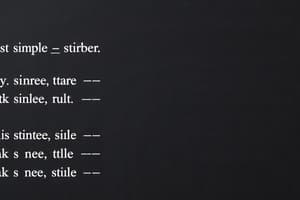Podcast
Questions and Answers
The past simple tense can be used to describe actions that were completed in the future.
The past simple tense can be used to describe actions that were completed in the future.
False (B)
Irregular verbs always follow the pattern of adding '-ed' to form the past tense.
Irregular verbs always follow the pattern of adding '-ed' to form the past tense.
False (B)
The structure of an affirmative sentence in the past simple tense includes a subject followed by 'did not' and the base form of the verb.
The structure of an affirmative sentence in the past simple tense includes a subject followed by 'did not' and the base form of the verb.
False (B)
To create a negative sentence in the past simple tense, the structure is subject + did not + base form of the verb.
To create a negative sentence in the past simple tense, the structure is subject + did not + base form of the verb.
The past simple form of 'go' is 'goed'.
The past simple form of 'go' is 'goed'.
Flashcards are hidden until you start studying
Study Notes
Past Simple: Overview
- The past simple tense is used to describe actions that were completed in the past.
Irregular Verbs
- Irregular verbs do not follow the standard pattern of adding "-ed" to form the past tense.
- Common irregular verbs and their past forms:
- be → was/were
- go → went
- have → had
- do → did
- see → saw
- make → made
- take → took
- come → came
- It’s important to memorize irregular verbs as they do not conform to regular rules.
Affirmative Sentences
- Structure: Subject + past simple verb
- Example: She visited her grandmother.
- Example: They went to the park.
- All subjects can be used with the past simple form of the verb.
- Example: I played soccer.
- Example: He watched a movie.
Negative Sentences
- Structure: Subject + did not (didn't) + base form of the verb
- Example: She did not visit her grandmother.
- Example: They did not go to the park.
- "Did" is used to form the negative, followed by the base form of the verb.
- Examples:
- I didn't play soccer.
- He didn't watch a movie.
Key Points
- Irregular verbs require memorization due to their unique past forms.
- Affirmative sentences use the past simple form directly, while negative sentences require "did not" plus the base form.
Past Simple: Overview
- Describes actions that are completed in the past.
Irregular Verbs
- Do not follow the standard "-ed" pattern for past tense formation.
- Notable irregular verbs and their past forms include:
- be: was/were
- go: went
- have: had
- do: did
- see: saw
- make: made
- take: took
- come: came
- Memorization of irregular verbs is essential due to their unique forms.
Affirmative Sentences
- Structure: Subject + past simple verb.
- Examples illustrate usage:
- "She visited her grandmother."
- "They went to the park."
- Applicable to all subjects:
- "I played soccer."
- "He watched a movie."
Negative Sentences
- Structure: Subject + did not (didn't) + base form of the verb.
- Examples include:
- "She did not visit her grandmother."
- "They did not go to the park."
- "Did" is integral in forming the negative, followed by the base verb:
- "I didn’t play soccer."
- "He didn’t watch a movie."
Key Points
- Memorization is crucial for irregular verbs due to their distinct past forms.
- Affirmative sentences directly employ the past simple, while negative sentences utilize "did not" plus the base form of the verb.
Studying That Suits You
Use AI to generate personalized quizzes and flashcards to suit your learning preferences.



